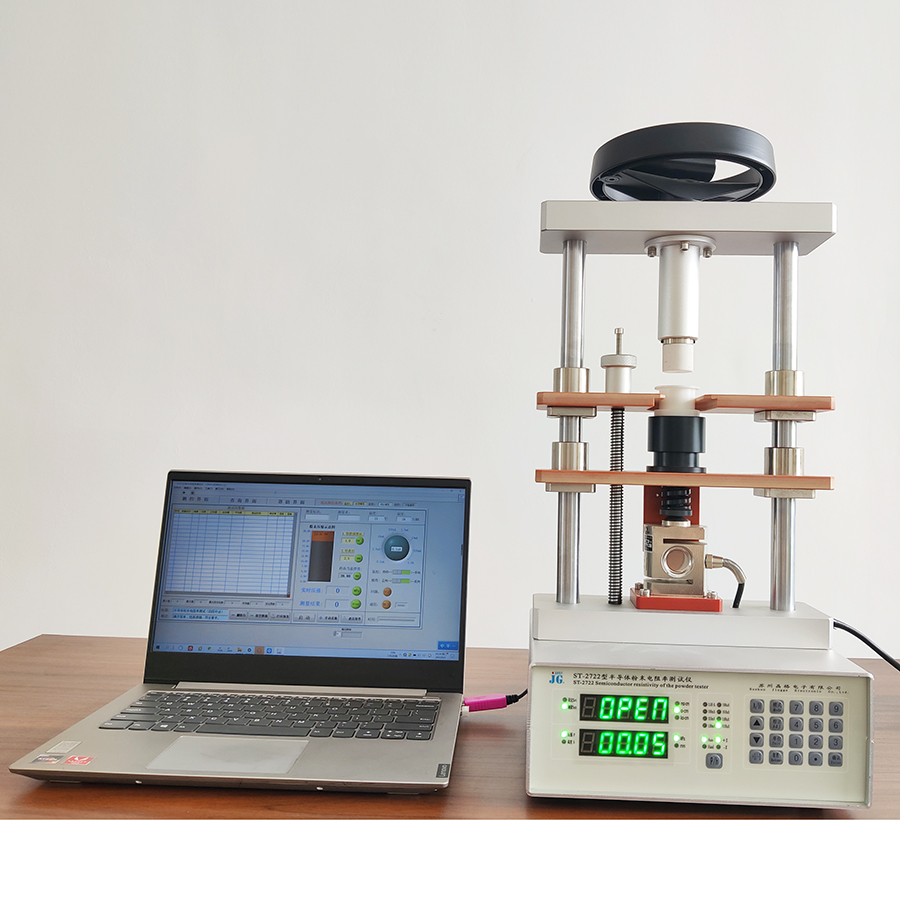ST2722-SZ four probe powder resistivity tester
AddDate: 2022/12/1 11:14:13
Hits: 3610
I. Structural features



II Overview
Instrument composition: The whole instrument consists of a host and a powder test bench.
The host is the core part of the electrical control display of the whole system, which is mainly composed of a precision constant current source, a high-resolution ADC, an embedded microcontroller system unit and a pressure thickness display unit.
The powder test bench is a device connected to the test host, used to clamp semiconductor powder (including polymer powder and metal powder), apply pressure (tablet) and conduct resistivity test synchronously (hereinafter referred to as the test bench).
The test bench is composed of powder standard container, electrode, pressurizing mechanism, pressure detection, thickness detection, connecting cable and other units.
Advantages: The design of the test bench conforms to the national standards and industrial specifications, and has won the national patent. There are two types.
Patent No.: Z L 201220082173.9
The design of the four probe method test bench conforms to the principle and specification of powder resistivity test in the new GBT 30,835-2014 "Carbon Composite Lithium Iron Phosphate Cathode Materials for Lithium Ion Batteries", with reference to GB/T 1551-2009 "Method for Measuring the Resistivity of Silicon Single Crystals", GB/T 1552-1995 "DC Four probe Method for Measuring the Resistivity of Silicon and Germanium Single Crystals", and the American A.S.T.M standard.
Four probe method synchronous pressure continuous test powder "resistivity pressure curve,"
Industry standard test method for powder resistivity.
ST2722 Example of connecting to software printing report

All parameter settings and function conversion of the instrument are input by digital keyboard; It has zero position and full degree self calibration functions; Full automatic range switching of voltage and current; The test result is directly displayed by the digital meter.
The pressure mechanism is manually operated, and the pressure (pressure) is stable, adjustable and maintainable. The electronic sensor automatically and synchronously detects and displays the pressure (pressure) value and sample height. Therefore, this test bench can simultaneously test the resistivity while pressurizing, which can facilitate the mapping of the "resistivity pressure" performance curve of powder samples; It can also be used separately as a tool for powder pressing into tablets. After the tablets are formed, they can be demoulded and taken out, and the relevant parameters can be tested with the common four probe method!
This tester is equipped with a complete set of PC software, so it can not only be operated independently (offline), but also be connected to PC software, automatically saving current test data, querying and statistical analysis of historical data, printing test reports, etc!
This instrument has the characteristics of high measurement accuracy, simple operation, good stability, good repeatability, and convenient use of one machine for multiple purposes. It is also a new feature different from the previous similar test bench! This instrument is applicable to carbon plants, coking plants, petrochemical plants, powder metallurgy plants, colleges and universities, and scientific research departments. It is an important excellent tool for testing and analyzing the quality of solid and powder samples.
III. Technical Parameters
1. Measuring range and resolution of resistivity
Resistivity: 15.0 * 10-6~200.0*103 Ω-cm Resolution 1.5 * 10-6 ~ 0.1 *103 Ω-cm
(1.0 × 10-6 ~200.0 × 101 Ω - cm resolution 0.1 × 10-6 ~ 0.1 × 101 Ω-cm)
2. Resistivity range division and error level
| Full scale display | 200.0 | 20.00 | 2.000 | 200.0 | 20.00 | 2.000 | 200.0 | 20.00 |
| Maximum extended range | KΩ-cm | Ω-cm | mΩ-cm | |||||
| Fundamental error | ± 2% reading ± 4 words | ± 1.5% reading ± 4 words | ± 0.5% reading ± 4 words | ± 0.5% reading ± 4 words | ||||
3. Digital voltmeter:
⑴ Range: 10mV ~ 100mV, automatic
⑵ Display: 4 significant digits, the maximum display is 999.9 decimal point, and the unit is automatically displayed
4. CNC constant current source
Current output: DC current 0.1 µ A~1000mA is adjustable, and the system automatically adjusts step by step.
5. Some parameters of powder test bench:
(1) Composition of the sample: There is no limit to the composition, but it shall not contain any component that can corrode the test bench and electrode.
(2) Sample size: the standard size is less than 40 meshes - more than 60 meshes (standard screen), and other sizes are also acceptable!
(3) . Sample container: inner diameter: Φ 11.28mm(S=1.0cm2)
Height: 0~20mm adjustable, with height sensor monitoring, measurement error: ± 0.05mm.
(4) Test pressure
Standard pressure: P0=4Mpa ± 0.05Mpa.
Pressure range: 30Mpa, P=0~30Mpa adjustable.
(5) The pressure mechanism is manually operated and the pressure is stable and adjustable.
The four digit effective display number is 00.00~30.00MPa, with a respective rate of ± 0.01 MPa.
6. Tester shape and weight
Front width * long * Total height=250mm * 220 mm * 540mm
Weight=10Kg
7. Power supply:
Power consumption:<10W
Input: 220V ± 10% 50Hz (110V ± 10% 60Hz)
8. The working conditions of the instrument are:
Temperature: 0-40 ℃
Relative humidity: ≥ 60%
There should be no strong electromagnetic interference in the studio, and the power supply should not be shared with high-frequency equipment.
IV. Contact information and purchase channels:
Sales Manager: Grace Zheng
Tel.:+8618762109211
Email: zhengjingjing@szjgdz888.com
Alibaba Store: https://szjgdz.en.alibaba.com
| Product Order: | ||






